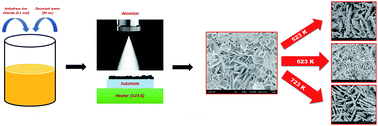A simple and template free synthesis of branched ZnO nanoarchitectures for sensor applications†
Abstract
Strong electrophilic natured acetaldehyde present in various food and beverages damages genetic material and induces diseases like atherosclerosis. Detection and quantification of such a carcinogen poses a major challenge. In this context, a novel room temperature acetaldehyde sensor made up of hierarchical ZnO nanostructures and prepared by a simple and template-free method has been reported. ZnO nanostructures were grown on glass substrates by a chemical spray pyrolysis technique at the substrate temperature of 523 K. Different nanostructures, namely tiny nanoplatelets, branched nanorods and thicker nanoplatelets, were formed by an annealing process. The crystal structures, morphologies and optical absorbances of the hierarchical ZnO nanostructures were investigated by X-ray diffraction (XRD), field emission scanning electron microscopy (FE-SEM) and UV-vis spectrophotometry, respectively. The branched nanorods showed an excellent sensing response towards 20 to 500 ppm of acetaldehyde vapour. The role of high density junctions of the branched ZnO architecture in enhancing the vapour sensing performance has been highlighted. The observed selectivity, range of detection and stability of the branched ZnO nanorods have proven their potential as a sensing element for the detection of acetaldehyde.



 Please wait while we load your content...
Please wait while we load your content...